East Ham (Corporation) Tramways
History
The first tramway services within East Ham began in 1886, and were for most of their circa 22-year lifespan horse drawn, though with a brief interlude of battery electric operation. The services ran along Romford Road westwards from Manor Park, crossing into neighbouring West Ham at Green Street; they were operated by the North Metropolitan Tramways Company.
By the late 1890s, East Ham Urban District Council was developing plans for an electric tramway, and in 1898, it successfully obtained powers to build 3.3 miles of lines; these powers were conferred on the 2nd August under the Tramways Orders Confirmation (No. 2) Act of 1898. Further powers, to build another 3.39 miles of tramway were obtained on the 6th August 1900 under the Tramways Orders Confirmation (No. 3) of 1900.
It is unclear when construction of the new standard-gauge overhead electric tramway started, but passenger services commenced on the 22nd June 1901, and though not the first electric trams in London, they were the first to be operated by a local authority. At the time of opening, only three lines of the system were ready: Manor Park to the Ilford boundary near Cranbrook Bridge; Manor Park to Becton level crossing; and Boleyn to the Barking boundary near the River Roding. The initial services were run by fifteen tramcars, probably the bare minimum the council thought it could get away with, and that only after being strongly advised that its original order (for ten cars) was wholly inadequate. The council's parsimonious attitude to its tramway was to plague the system for many years; not only did the tramway manager have to initially put up with an inadequate number of tramcars, he also had to watch the system's profits being siphoned off for rate relief, with not a penny being put aside into a sinking fund for renewals.
The tramway was an immediate success, such that the council quickly had to dip into its pockets for another five tramcars, which arrived in 1901, and took the fleet to 20 vehicles. The rest of the system opened as follows: Manor Park to the City of London Cemetery Gates (27th March 1902); High Street North to Green Street via Plashet Grove (29th November 1902); Cemetery Gates to Wanstead Park Avenue (10th March 1903); and Becton level crossing to Cyrus Place at the Royal Albert Dock (25th March 1903). Another ten tramcars arrived in 1902, followed by another five in the summer of 1903, taking the fleet to 35 vehicles.
On the 10th August 1903, East Ham attained borough status, the tramcar fleet eventually carrying the title East Ham Corporation Tramways rather than the earlier East Ham Tramways.
In 1904, the East Ham system was connected to that of neighbouring West Ham at Boleyn, services commencing between Canning Town (in West Ham Borough), and the Barking boundary on the 31st March 1904; the services were operated by both EHCT and West Ham Corporation Tramways cars. Conductors were initially changed at the East Ham/West Ham boundary, though the practice was relatively quickly abandoned. In the following year a connection was made to the system of East Ham's northeastern neighbour, Ilford Urban District Council, the latter agreeing to lease its section of track — from the East Ham boundary, along Ilford Hill to Ilford Broadway — to East Ham. The services, which began on the 12th April 1905, ran from Manor Park to Ilford Broadway, and were wholly operated by East Ham. Although some authors have claimed that the connection was delayed due to obduracy on the part of Ilford UDC, it seems more likely to have been due to the need to build a new bridge over the River Roding.
A further lease agreement was reached at the behest of Barking Town Urban District Council, which was not, at the time, in a position to operate its newly built line between the East Ham boundary (on Barking Road) and Barking Broadway. Services commenced on the 17th November 1905, and as they were simply an extension of the existing Canning Town services, they were operated jointly by the EHCT and the WHCT. Five more tramcars were acquired in 1905, and a significant programme of top covering was initiated.
Another connection was made with the West Ham system at the end of Plashet Grove, but this time services, which commenced on the 1st November 1907 between Stratford Broadway and East Ham Town Hall, were only operated by WHCT cars.
During the creation of the area's electric tramways, the North Metropolitan Tramways Company had continued to operate its horse trams, though by mid 1906, all that remained of its once extensive system was the line along Romford Road between Manor Park and Green Street. Although this stretch of line was wholly within East Ham, the company's lease ran until 1911, so it had a strong bargaining position when the corporation sought to purchase the tramway much earlier than this. Agreement was, however, reached, the corporation taking possession of the line on the 29th April 1908, the NMTCo operating its last ever horse-tram service the day before. The corporation quickly set about converting the line to overhead electric traction, though this was hampered by the railway overbridge at Woodgrange Park, which needed rebuilding. Although electric tramway services commenced on the 1st August 1908, these were in two halves, the western half (from Bow Bridge to Woodgrange Park) being operated by WHCT cars, and the eastern half (from Woodgrange Park to Ilford Broadway) being operated by EHCT cars. This situation lasted until the 10th March 1909, when through services commenced; this required an amendment of the Ilford lease to allow WHCT cars to work through to Ilford Broadway.
In 1909/1910, the corporation's thoughts turned to the prospect of through services to central London over the London County Council's expanding conduit tramway system, five conduit-equipped cars being ordered, which took the fleet to 45 vehicles. Services between Ilford Broadway and Aldgate commenced on the 11th May 1910, and were worked jointly by London County Council Tramways, the WHCT and the EHCT. This necessitated yet another amendment of the Ilford lease, its periodic renewal proving to be a bone of contention over the years, Ilford UDC repeatedly claiming that the heavy LCCT bogies cars were damaging its track.
The joint EHCT/WHCT Canning Town to Barking Broadway service was extended during 1910 to Poplar in the west, and Loxford Bridge in the east; services over the fully extended route commenced on the 17th November 1910, and initially included Barking Town Council Tramways. The services were extended to Aldgate on the 20th December 1912 over the LCCT's conduit lines, the LCCT joining in the joint service agreement; this however, lasted for barely 15 months before Barking withdrew, the services being cut back to Barking Broadway on the 31st May 1914.
Fortunately for East Ham, it had just embarked on a tramcar rebuilding programme when the Great War broke out, and was therefore able to complete seven tramcars before the government pulled the plug. The following year saw the addition of a second-hand car from Barking, and the elevation of East Ham to a county borough. As with all tramway systems, the war years were very difficult, with loss of men (and skills) to the armed forces, severe restrictions on procurement of new materials and spares, and heavily loaded services running over ever-more decrepit track. By 1919, the tramway was extremely run down, with just about everything in need of replacement. As soon as its finances permitted, the corporation embarked on a major programme of renewal, which saw ten new tramcars arriving in 1921/1922, and work begin on track and overhead renewal. By 1924, the entire system had been relaid with new track and overhead, with only the tramcars in need of replacement.
Despite this investment, severe unregulated motorbus competition led to a proposal to replace the main north-south line (Wanstead Park to the Royal Albert Docks) with trolleybuses, to see whether this would improve matters. Unfortunately for the proponents, the ratepayers were far from happy, and succeeded in having the proposed bill withdrawn. Instead, ten modern tramcars were acquired in 1927, and their deployment led to a significant upturn in passenger numbers, such that another ten were ordered, these arriving in 1928.
The last five years of the EHCT's existence were fairly uneventful, the system passing into the hands of the newly formed London Passenger Transport Board, along with thirteen other systems, on the 1st July 1933.
At its maximum, East Ham Corporation operated 8.34 miles of standard-gauge, electric tramway. The system took the form of a long north-south line running southwards from Wanstead Park through Manor Park, along High Street North to East Ham Town Hall, then along High Street South and East Ham Manor Way to the Royal Albert Docks. At Manor Park, this line was crossed by a line from the borough boundary at Green Street in the west, where it met the WHCT, to Ilford Broadway in the east, where it met the tracks of Ilford Council Tramways. Further south near East Ham Station, a line branched off westwards along Plashet Grove to Green Street, where it met the tracks of the WHCT. At East Ham Town Hall, the main north-south line was crossed by another line, from Boleyn in the west, where it connected to the WHCT, to Barking Broadway in the east, where it met the tracks of Barking Town UDC Tramways.
The last tram service to run over former EHCT tracks ran on the 8th June 1940, operated by the LPTB.
Uniforms
Unfortunately, photographs depicting crews and staff working East Ham Council Tramways are surprisingly rare, so it is only possible to provide a rather sketchy overview of the uniform story. Motormen and conductors initially wore double-breasted jackets (of dark-blue serge) with four pairs of brass buttons (bearing a stylised monogram of the system initials — see link) and lapels; it is currently unclear whether the collars bore badges of any kind. Caps were of the drooping-peak variety; they bore large cloth badges embroidered with silver and gold-coloured wire, possibly bullion thread. The badges included a simple representation of the East Ham municipal device, above which was the system title, 'EAST HAM TRAMWAYS' in a ribbon, and below which was the grade, either 'MOTORMAN' or 'CONDUCTOR'.
At some point, possibly in the mid-Edwardian era, the uniform jacket was changed to a double-breasted, lancer design with five pairs of buttons (narrowing from top to bottom), epaulettes and stand-up collars; the left-hand collar bore an employee number, the right-hand collar system initials — 'E H T' — in individual brass letters. The epaulettes also carried a badge, possibly a representation of the East Ham municipal device, though this remains unproven photographically. The uniforms were of blue serge with red piping.
The drooping peak caps eventually gave way to tensioned-crown peaked caps, and the embroidered cloth cap badges to new ones of the same overall design, but in brass; the system title ribbon was inlaid with blue enamel (see below), with the entire ensemble mounted on a dark leather backing. It is currently unclear when this change took place, but more than likely in the mid-Edwardian era.
In the 1920s, the uniform was changed once again, this time to a more modern single-breasted design with lapels; it is currently unclear what badges the uniform bore.
Tramcar staff were also provided with greatcoats, which were double-breasted with high, fold-over collars and epaulettes; it is possible, but by no means certain, that the left-hand collar carried insignia of some description, more than likely an employee number.
Motormen and conductors always appeared in service wearing enamel Public Carriage Office licence badges, which were issued by the Metropolitan Police (see link).
Photographs of inspectors are yet to come to light, so it is currently impossible to say what uniforms they wore.
Only a single photograph of an East Ham Corporation Tramways Great War conductress has so far come to light; the subject is wearing a double-breasted overcoat with high, fold-over collars, the right-hand side clearly bearing individual system initials, 'E H T'. The only glimpse of the tunic worn underneath are the stand-up collars, both of which bear system initials. The hat in the photograph is a dark-coloured waterproof bonnet, which was probably for summer wear; it is unclear whether the hat bore a badge or not.
Further reading
For a history of the system, see: 'The Tramways of East London' by Rodinglea; The Tramway & Light Railway Society and The Light Railway Transport League (1967).
Images
Motormen and conductors
A brand-new Tramcar No 11 undergoing trials in Boleyn Green Street in 1901. Photo courtesy of the Tramways and Light Railway Society, with thanks to Eddie Dawes.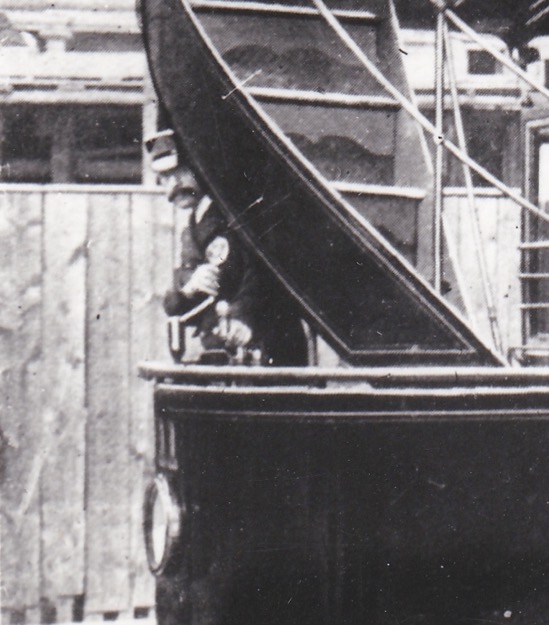
An enlargement of the above photograph showing the motorman in his drooping-peak cap, which carries a prominent embroidered cloth cap badge.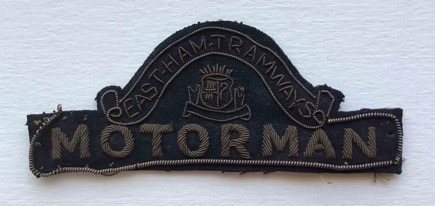
East Ham Tramways motorman cap badge, bullion-embroidered cloth. This pattern of badge was probably worn between 1901 and circa 1905. With thanks to Keith Turner.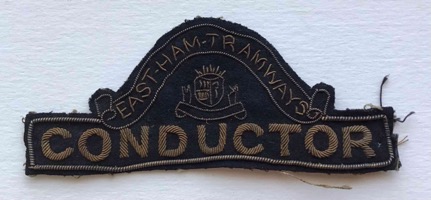
East Ham Tramways conductor cap badge, bullion-embroidered cloth. This pattern of badge was probably worn between 1901 and circa 1905. With thanks to Keith Turner.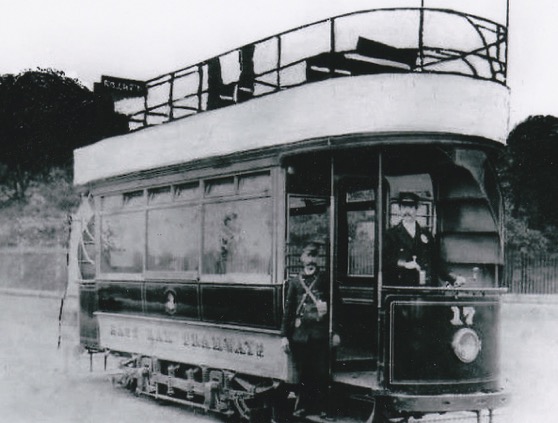
An extremely heavily, and badly, touched-up image of Tramcar No 17 at the depot in 1901. Both crew members are wearing drooping-peak caps and double-breasted jackets with lapels. Photo courtesy of the Tramways and Light Railway Society, with thanks to Eddie Dawes.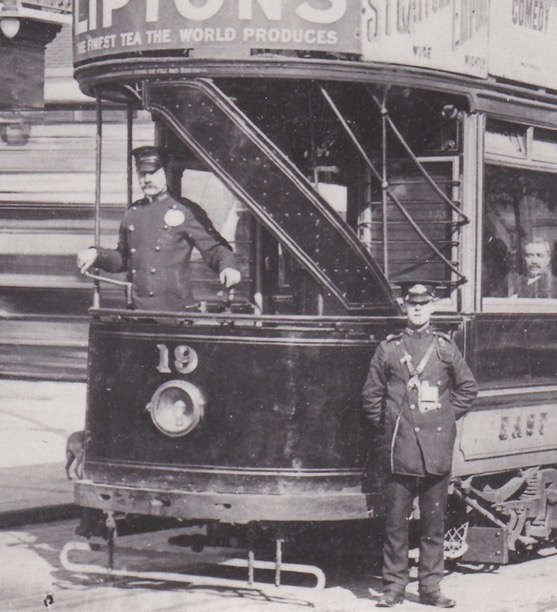
The crew of Tramcar No 19 (in top-covered condition) pose for the camera outside the Burnell Arms on Plashet Grove — photo undated, but probably taken shortly after the Great War. Photo courtesy of the Tramways and Light Railway Society, with thanks to Eddie Dawes.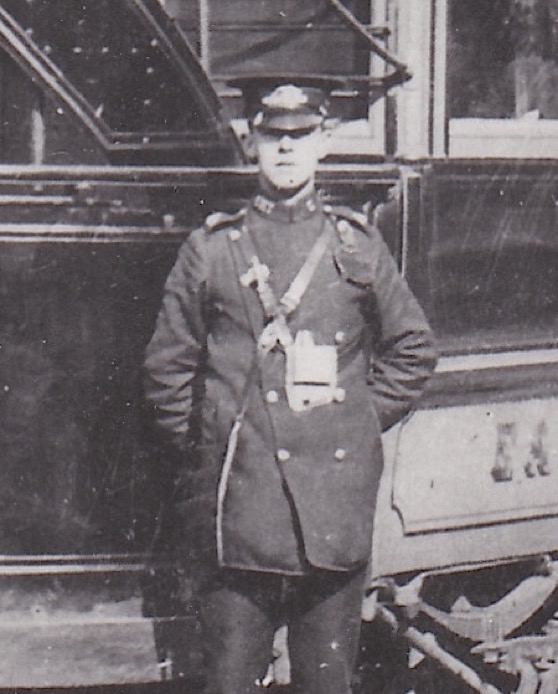
An enlargement of the above photograph showing the conductor. By this time, and probably from the mid-Edwardian era, the drooping-peak caps had been superseded by tensioned-crown peaked caps; these bore a new design of cap badge, mimicking the old one, but in brass/gilt and blue enamel. The conductor's right-hand jacket collar bears system initials, 'E H T', whilst his left-hand collar carries an employee number (possibly '5'). His epaulettes also carry a badge of some description, probably the East Ham municipal-device badge shown below.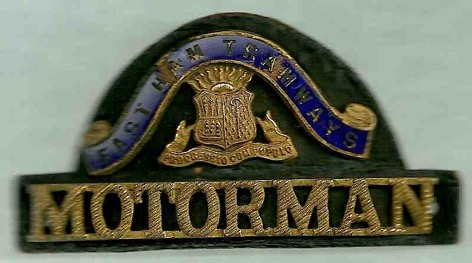
East Ham Corporation Tramways motorman cap badge — brass and blue enamel on a leather mount. This pattern of cap badge was probably worn from the mid-Edwardian era through to 1933. With thanks to Stephen Howarth.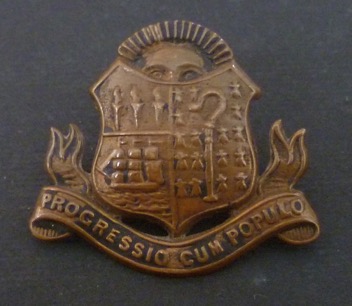
East Ham municipal-device badge — brass. This was probably the pattern of badge worn on the jacket epaulettes from the mid-Edwardian era onwards. Author's Collection.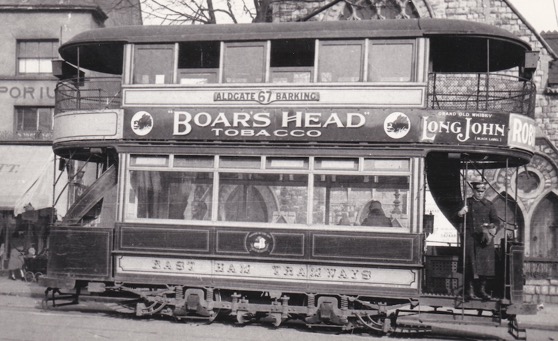
An unidentified East Ham car at Barking with a No 67 service to Aldgate — photo undated, but probably taken in the late 1920s. Photograph believed to have been taken by G N Southerden, courtesy of the Tramways and Light Railway Society, with thanks to Eddie Dawes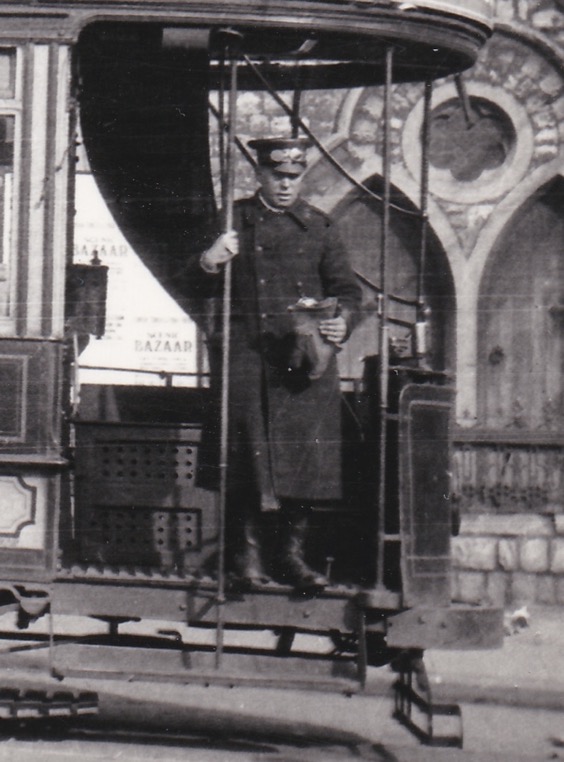
An enlargement of the above photograph showing the motorman; he is wearing a double-breasted greatcoat, along with heavy mitts and goggles (on his cap).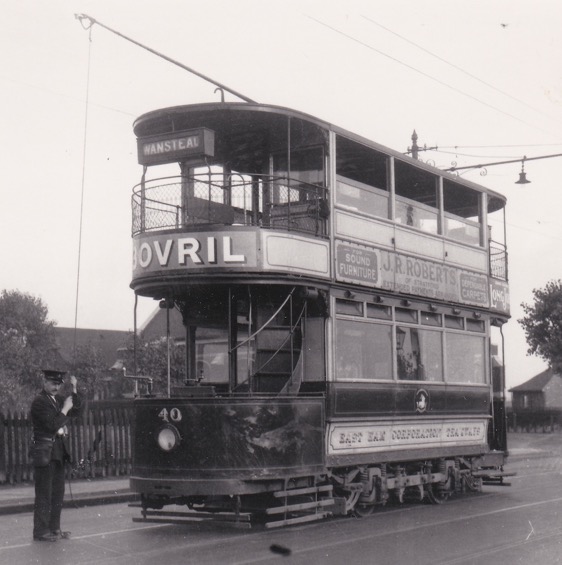
The conductor of Tramcar No 40 turns the trolley pole outside the Northern Outfall Sewer (Royal Albert Docks terminus) in 1927. Photo courtesy of the Tramways and Light Railway Society, with thanks to Eddie Dawes.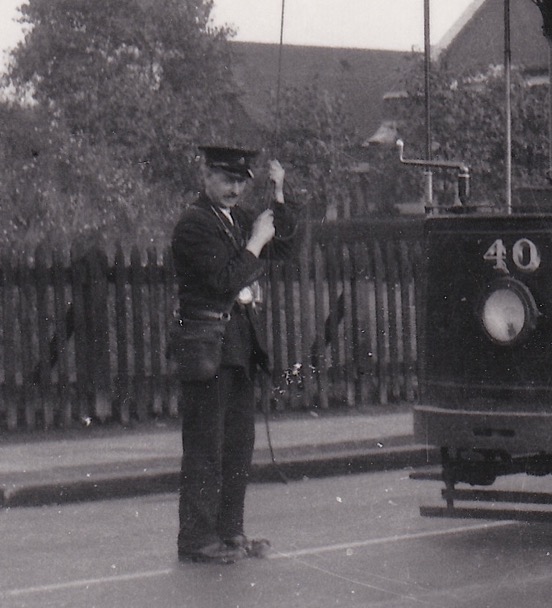
An enlargement of the above photograph, showing the conductor, by this time in a single-breasted jacket with lapels.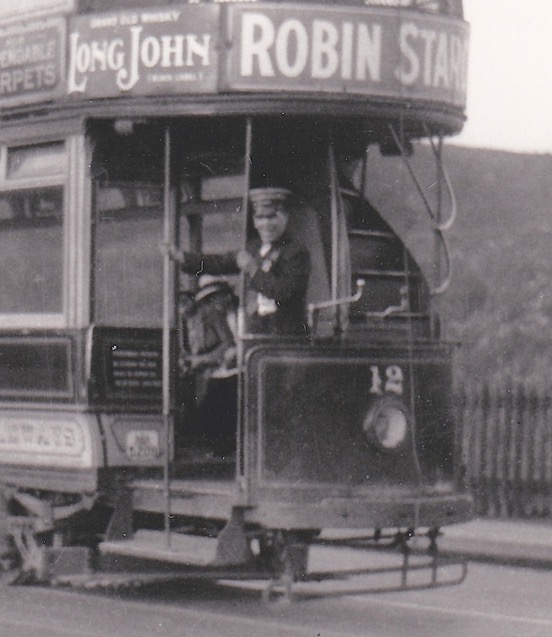
Another shot taken at the Northern Outfall Sewer, this time of Tramcar No 12 around 1930. Photo courtesy of the Tramways and Light Railway Society, with thanks to Eddie Dawes.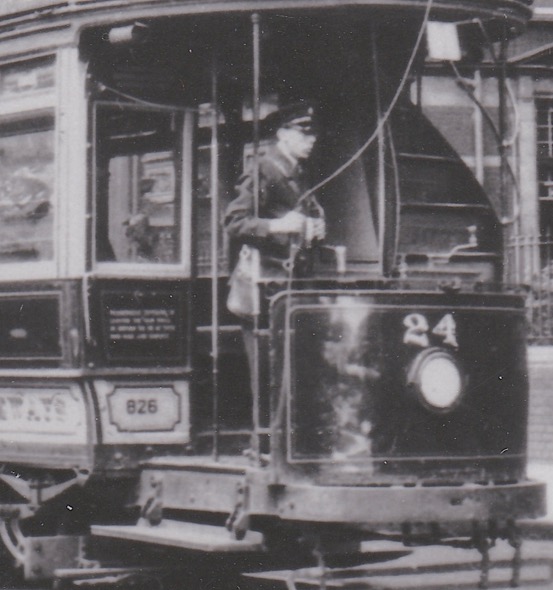
The conductor of Tramcar No 24 focuses his attention on some unknown event out of shot to the right — photo undated, but taken around 1930 outside East Ham Town Hall. Photo courtesy of the Tramways and Light Railway Society, with thanks to Eddie Dawes.
Female staff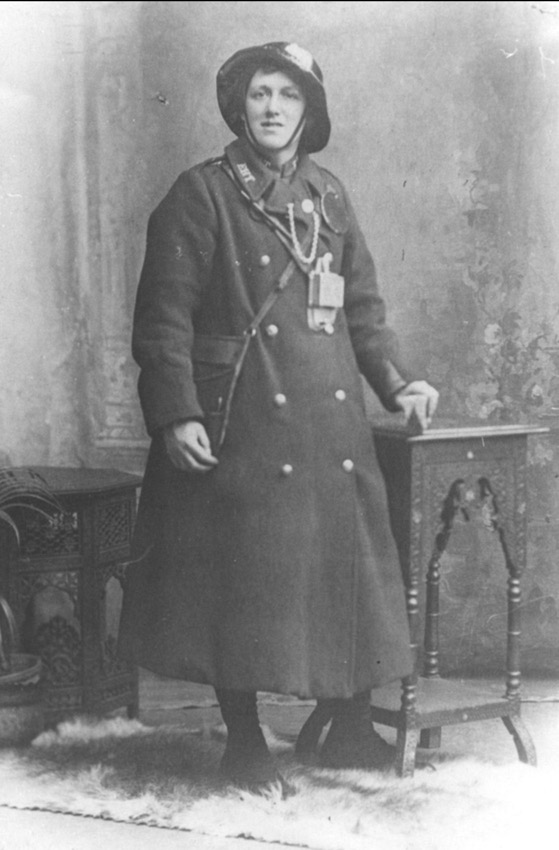
East Ham Tramways first Great War conductress, Miss D Turner — photo dated 1915.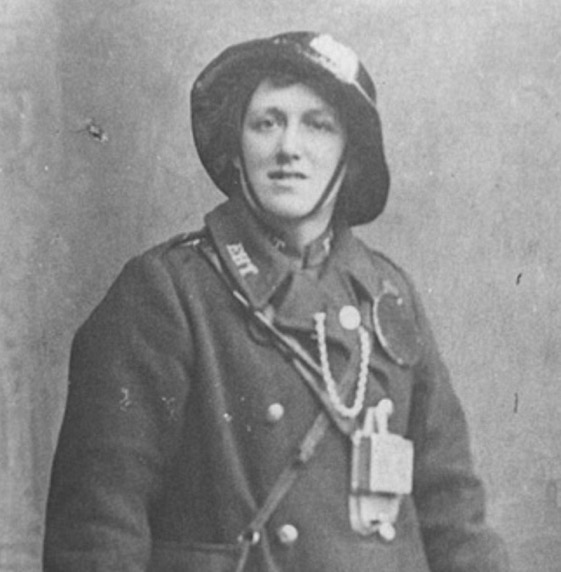
An enlargement of the above photograph showing details of the uniform. The subject's right-hand topcoat collar bears individual system initials, 'E H T'; the left-hand stand-up collar of the jacket she is wearing beneath the topcoat also bears individual metal system initials. The situation with respect to her waterproof bonnet is unclear, due to the reflections from it.